What foods are incompatible with each other in the dietetics of Chinese medicine? Incompatible foods
Many have heard about the idea of \u200b\u200bproduct compatibility, but few have resorted to it in practice. It seems difficult, requiring willpower, which is sorely lacking. In fact, such a system does not require large moral costs, because it does not imply a hunger strike or any restrictions, but the observance of certain rules. Popular in the early 19th century, the theory of separate nutrition for weight loss still finds its supporters. There are many opponents who expose the very idea and its founder.
Separate nutrition is based on the idea of \u200b\u200bfood compatibility, common to all people. Shelton believed that the enzymes produced by the stomach to digest different types of food are different. So, the enzymes necessary to break down carbohydrates will not be able to process proteins and vice versa. If you eat one type of food at one time, this will greatly facilitate the process of digestion and assimilation.
If preference is given to traditional food, in which a mixture of different ingredients takes place, then the stomach begins to secrete several enzymes at once. As a result, some foods break down faster, others slower, which leads to their long stay in the stomach. This, in turn, entails the processes of fermentation, decay, causes intoxication of the body, metabolic processes are disrupted. As a result - overweight, slagging, poor health.
According to Shelton and his followers, certain groups of products should not be combined with each other, they should not be consumed after the previous food is digested and assimilated. Following the separate nutrition system, it is necessary to abandon tea and coffee, shop juices, products containing preservatives, since here the mixing of ingredients has already occurred.
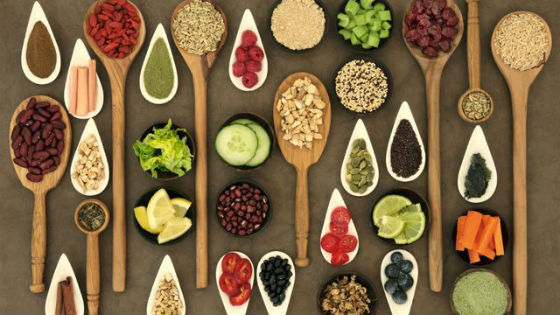
Product groups requiring different enzymes
Separate nutrition for weight loss has the main rule: never consume proteins with carbohydrates at the same time. In order for the proteins to be assimilated, an acidic environment is required; an alkaline environment will be needed to break down carbohydrates. If you eat proteins together with carbohydrates, alkaline and acidic enzymes will be simultaneously released for assimilation, neutralizing each other. The digestion process as a result noticeably slows down, not all food will be processed in the stomach.
Products requiring an acidic environment (protein foods):
- all types of meat;
- eggs of any bird;
- fish and seafood;
- milk and products from it (including cheese);
- mushrooms and nuts.
Starch is considered one of the most common carbohydrates. Starchy vegetables include potatoes, green peas, pumpkin, zucchini, cabbage, carrots, beets. Little starch is found in green vegetables: cucumbers, celery and others. Carbohydrates in the form of sugar are found in honey, sweet fruits and dried fruits. This product group will require an alkaline environment. In addition, it is necessary for the processing of cereals and products from flour, bananas, chocolate and sweets, and other sweets. Beer also refers to carbohydrates, so its combination with fish and meat is unacceptable.
Fats are vegetable oils, meat and fish of fatty varieties, nuts and seeds. Half-sour fruits - sweet apples, pears, apricots and peaches, plums, many berries.
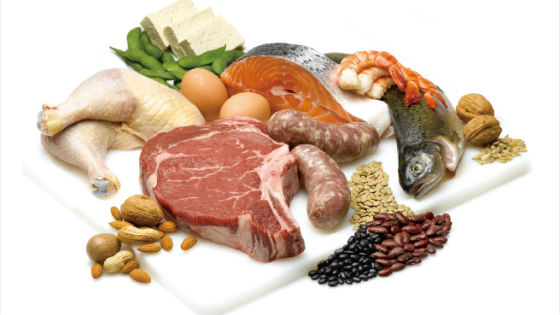
Invalid combinations with separate meals
Based on data on the composition of the products for the digestion of which different enzymes are necessary, Shelton derived combinations that are unacceptable to be used together:
- Protein + protein (especially saturated). You can not combine, for example, meat and fish, add eggs or nuts to them. All this contains protein, qualitatively different from each other. To digest such dishes, a considerable amount of gastric juice is necessary, they will be processed and passed through the digestive tract for a very long time. From here discomfort arises: gas formation, bloating, disturbances in the intestines.
- Proteins + fats (including vegetable). Fat envelops the stomach, preventing the gastric juice from forming in an amount sufficient to process and digest the protein. As a result, food is digested longer, part of it remains completely unprocessed.
- Proteins + acids. Sour fruits should not be eaten together with protein foods: meat, eggs, cottage cheese. The acids secreted by the stomach are enough to break them down. Fruits only slow down the process, cause increased acidityheartburn. You can’t eat acidic fruits immediately after protein: protein is digested mainly in the stomach, therefore it is there for 4-6 hours, while the assimilation of fruits and berries occurs in the intestine, they are in the stomach for only half an hour. Having been here longer, they begin to wander, all the beneficial properties decay.
- Carbohydrates + acids. Digestion of carbohydrates requires an alkaline environment, while excessive acidity destroys the ptyalin enzyme necessary for the breakdown of carbohydrates.
- Carbohydrates + carbohydrates. Carbohydrate-rich foods slow down the digestion process and slow down your metabolism. Excess carbohydrates accumulate in the body in the form of fats. That is why it is not worth seizing mashed potatoes with bread.
- Carbohydrates + sugar. Sweet food does not go well with anything. If you really want to treat yourself to a piece of cake or your favorite sweets, it is better to do it separately from the rest, as an independent meal, and not as an addition to it in the form of a dessert. Sweet is better before lunch, so that it does not affect weight loss.
- Milk should not be consumed with anything, only as an independent drink, replacing a meal. In general, Sheldon believed that a person can do without milk. This is a kids product. Each animal has a special composition of milk (cow, goat, and breast milk, which are completely different in their properties). It is practically not processed by the body, so there is little benefit from it.
- Melon is very healthy, contains many vitamins and minerals, cleanses the body. But you need to eat it strictly separately. If you use it in conjunction with any other food, it will not bring benefits.
Separate nutritional compatibility table
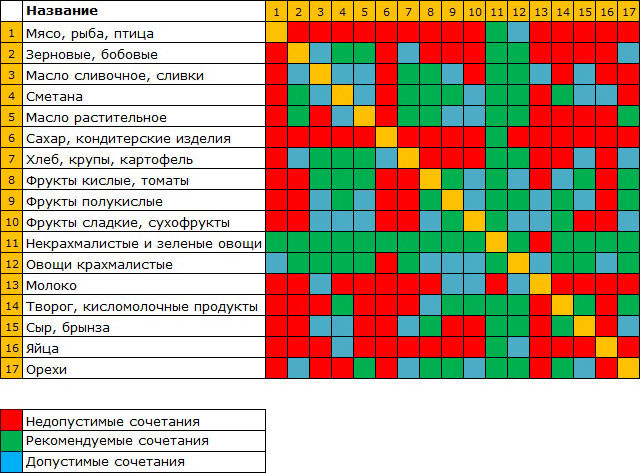
How to use a table
The table below the numbers shows the main product groups (vertically and horizontally). To understand whether it is possible to combine certain ingredients in cooking, just find them, find out the numbers and look at the color that appears when they intersect. For example, fish and meat (1) go well with non-starchy vegetables (11), their combination with starchy vegetables (12) is acceptable. But the rest of the cells are shaded in red - these are products that can not be consumed with meat.
Sample menu for 1 day (taking into account the table data)
Guided by the principles of combination, it is not difficult to make a menu with separate meals.
Breakfast
Fried eggs with herbs (protein version)
Boiled porridge (carbohydrate version)
Dinner
Boiled chicken breast or steamed fish (protein version)
Baked (boiled) potatoes or pasta (carbohydrate version)
Dinner
Cottage cheese or kefir (yogurt without additives)
Salad of fresh vegetables or fruits (carbohydrate option)
It's important to know: Carbohydrate foods should alternate with protein-containing fats or acidic foods. So, if protein food was eaten for breakfast, then carbohydrate for lunch, and dinner should consist of fruits.
Video: Separate nutrition: the essence of diet and menu
Benefits of Separate Power
Many diets are based on the rejection of certain products, restrictions, which often causes malfunctions in the body, which does not receive the necessary substances in full. For the same reason, it is difficult for diets to cope with excess weight, because after stress the body stores substances for the future in case of another shortage. Separate consumption is not a diet in the generally accepted sense, it is rather a system proper nutritionwhich can be followed all the time. In addition to losing weight, the adherents of the system consider the advantages of separate nutrition:
- Normalization of metabolism. Improper functioning of the digestive system often causes overweight. The establishment of metabolic processes leads to the fact that food does not linger in the body longer than usual, all unnecessary substances leave it in a timely manner, not being deposited in the form of fat.
- The establishment of the cardiovascular system. Since with separate nutrition in the body the processes of decay and fermentation completely cease, then the decay products, the main cause of atherosclerotic lesions of blood vessels, do not enter the bloodstream. With this approach, almost all cholesterol is excreted, and the new one no longer accumulates.
- A varied menu. You can use almost everything. The main thing is to stick to compatibility. When following the principles of separate nutrition, there is no feeling of hunger, since the goal is not to limit, but to improve digestion and assimilation of food. It is noted, however, that a serving should not exceed 300-400 g in one go.
Separate nutrition does not involve eating food at regular intervals. It is important to wait for a slight feeling of hunger, then proceed to food. Two are enough for some. If the next day you want to eat three times, you do not need to suppress hunger. Sooner or later, the body itself will choose a regimen.
Video: Nutritionist Kovalkov: myths about separate nutrition. What really matches
Arguments of Supporters and Opponents of Separate Nutrition
Supporters of separate nutrition do not base their assumptions on any research, but on the belief that initially humans, like other mammals, consumed foods unchanged (that is, only meat or only vegetables). After some time, people learned to mix different ingredients to improve their taste.
Opponents argue that a separate nutrition system is basically impossible, because there are practically no products containing only protein or only carbohydrates (except for sugar and egg protein). They debunk the basic idea of \u200b\u200b“rotting food in the stomach,” from which, according to Shelton, health problems and overweight arise.
Doctors (S. Baxter, E. Chedia, L. Vasilevskaya and others) proved that, in addition to gastric, pancreatic enzymes are involved in the processing. In addition, R. Minvaleev, a physiologist and candidate of biological sciences, notes that only the preliminary processing of food occurs in the stomach, it is split and absorbed completely in the duodenum. All possible enzymes are produced here, regardless of which species follows the digestive tract (only protein, only carbohydrate, acidic or mixed).
Much that a person consumes together, really requires the development of various enzymes, but they do not interfere with each other, but complement and help break down indigestible substances. This leads to the fact that food is quickly processed, and its remnants leave the body without harming it. Opponents of a separate power system give the following arguments:
- Meat protein will be absorbed worse if you do not use it together with carbohydrates (bread or vegetables), which activate the production of pancreatic enzymes necessary for processing protein in the intestines.
- Sour fruits help to absorb iron, so they are often consumed with cereals.
- Fiber, which is sufficient in any vegetables, is important for proper functioning and timely bowel cleansing. Vegetables have always been considered a great addition to meat, because the fiber that they contain is necessary for proper functioning and cleansing of the intestines.
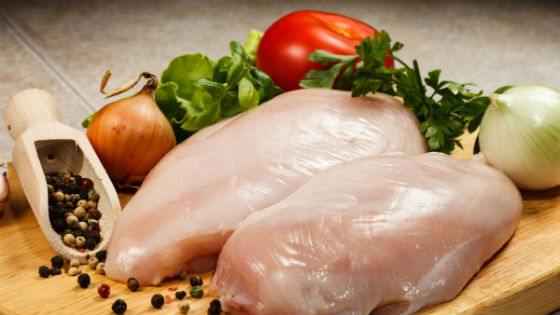
Nevertheless, separate nutrition for weight loss is suitable by reducing the calorie content of the food and streamlining its intake. Much of what Shelton suggested is the basis healthy eating. For example, everyone knows that it is better not to fry meat (proteins + fats), but to cook, stew or steam. And fruits are really better to eat separately, they are absorbed together with fats.
How not to combine Shelton products?
You can not combine proteins and carbohydrates in one meal
That is, meat, fish, cheese, eggs, mushrooms, nuts are incompatible with bread, potatoes, cakes, sweet fruits.
As already mentioned, the assimilation of these products is different. Digesting proteins, the stomach enhances the acidity of the juice. But this same acidity stops the absorption of carbohydrates (it occurs only in an alkaline environment). Products interfere with each other. With the simultaneous consumption of incompatible foods, such as proteins and carbohydrates, fermentation begins!
Unacceptable combination of proteins - proteins
Meat and eggs, meat and nuts, meat and fish, cheese and eggs, eggs and milk, cheese and nuts, etc.
Each protein is different in composition and requires a different assimilation time. When combined, they are not completely absorbed.
Incompatible proteins and fats
Do not use such incompatible productslike meat, eggs, cheese, fish, nuts, etc. They should not be consumed with butter and vegetable oil, with animal fat, since fat inhibits the secretion of gastric juices, which reduces Shelton’s overall digestive activity by 5- 10%.
Proteins and acids do not combine
These are incompatible products such as meat, eggs, etc. These products are not combined in one meal with tomatoes, vinegar, tomato juice, sour fruits. In theory, proteins are absorbed in an acidic environment. What could be in the way? The fact is that the stomach does not need additional acids, secreting the necessary and sufficient amount of acids itself. Fruit acids inhibit the natural secretion of gastric juice, as a hindrance to the digestion of protein. The result of the use of incompatible products is rotting!
Incompatible Food
Incompatible carbohydrates and acids
Bread, potatoes, peas, beans, sugar, honey, jam should not be eaten with citrus, sour grapes, apples, plums, sorrel, tomatoes, as the acid destroys the ptyalin enzyme necessary for the breakdown of carbohydrates.
Do not combine carbohydrates and starchy carbohydrates
So incompatible products in this case are: bread with potatoes, mashed potatoes, potatoes and a sweet cake. The stomach is able to cope with only one type of starch, the rest will not digest, they will delay the passage of food. The result is fermentation!
Do not combine carbohydrates and sugar
This means that we must abandon such incompatible products as jam pies, cereal and pasta casseroles, sweet cereals, jam and honey on bread or cereals. This combination causes fermentation!
Shelton Product Compatibility List
- Proteins go well with green non-starchy vegetables.
A piece of meat or fish with a green salad (without tomatoes) is a great combination!
- Squirrels with starchy vegetables (pumpkin, eggplant, zucchini, squash) combine well.
- Legumes go well with fats (sour cream, vegetable oil).
- Legumes go well with green non-starchy vegetables and starchy vegetables.
- Butter, cream - these products go well with bread, cereals, potatoes, green vegetables, and starchy vegetables.
- Sour cream is well compatible with bread, cereals, potatoes, sour fruits, tomatoes, green vegetables, starchy vegetables, cottage cheese, and dairy products.
- Vegetable oil goes well with legumes, bread, cereals, potatoes, sour fruits and tomatoes, green vegetables, starchy vegetables, and nuts.
- Bread, cereals, potatoes are well compatible with butter, with sour cream, with vegetable oil, with green vegetables, with starchy vegetables.
- Sour fruits, tomatoes are well compatible with butter, cream, sour cream, with vegetable oil, with green vegetables, cheese, feta cheese, and nuts.
- Sweet fruits are not bad compatible with sour fruits, with green vegetables, with cottage cheese, with sour-milk products.
- Green and non-starchy vegetables are perfectly compatible with all other product groups (with the exception of fresh milk).
- Starchy vegetables go well with legumes, with butter, cream, with sour cream, with vegetable oil, with bread, cereals, potatoes, with green vegetables, with cottage cheese and sour-milk, with cheese, feta cheese, with eggs, with nuts. A combination with meat, fish, poultry, with acidic fruits, tomatoes, with sweet fruits, with eggs is also acceptable.
- Cottage cheese, sour-milk products are well compatible with sour cream, with sweet fruits, with green vegetables, with starchy vegetables, with cheese, feta cheese, with nuts, a combination with sour fruits, tomatoes is acceptable.
- Cheese, feta cheese are perfectly compatible with sour fruits, tomatoes, green vegetables, starchy vegetables, with cottage cheese, dairy products, combinations with butter, cream, sour cream, bread, cereals, potatoes, and nuts are acceptable.
- Eggs go well with green vegetables; combinations with sour cream and starchy vegetables are acceptable.
- Nuts are well compatible with vegetable oil, sour fruits, tomatoes, green vegetables, starchy vegetables, cottage cheese, sour-milk products. Combinations with legumes, with bread, cereals, potatoes, with sweet fruits, with cheese, and feta cheese are also acceptable.
A properly composed diet is the basis of well-being, quality of life, longevity and health of any person.
In order to avoid negative effects on the digestive organs, the immune system and the figure, when composing the menu, you should always consider that some products are incompatible with each other.
The first and main rule of nutrition is its maximum simplicity. The more complicated the prepared dish, the more components in its composition, the greater the load on the gastrointestinal tract, digesting it. And if at one meal you absorb several different dishes, such as during any feast, and even liberally sprinkle all this splendor with alcoholic and carbonated drinks, then the load on the digestive system increases significantly.
There are a number of incompatible products that, when absorbed in one meal, cause a side negative effect - a significant reduction or complete cessation of the absorption of nutrients (trace elements, vitamins, amino acids). Some products prevent the body from fully assimilating each other, and some, when digested together, release toxic substances that poison the body.
The use of incompatible food products always leads to intoxication of the body, even if a person does not feel any discomfort. This means only that the body is strong enough and still independently and painlessly copes with toxic substances. Regular mixing of incompatible substances weakens the body, undermining its immunity, and over time can lead to serious health problems.
Which products are incompatible?
It's believed that following products It is desirable to use separately:
- Source foods for carbohydrates and acidic foods. Potatoes, cereals, bakery products, dried fruits, legumes are not friends with citrus, pickled fruits, pineapple, tomato. An enzyme called ptyalin, which is responsible for the breakdown of carbohydrates, can act only in an alkaline environment, and not in an acidic one.
- Sources of concentrated protein and carbohydrate products. Meat, fish, soybeans, mushrooms, eggs, cottage cheese, cheese, legumes are not friends with fruits, honey, bread, cereals, potatoes, sweets, juices. The method of digestion of these products is so different that being simultaneously in the stomach, they simply interfere with the assimilation of each other.
- Fat-containing products and protein foods. Cream, butter and other animal oils, as well as vegetable oils are not friends with meat, cheese, fish, eggs, mushrooms, beans. Fat helps to suppress the secretion of gastric juice, designed for the breakdown of protein foods.
- Starchy foods and fast carbohydrate source foods. Flour products, potatoes, cereals are not friends with any sweets - sugar, jelly, jam, molasses, honey, pastille, sweet fruits and dried fruits. Once in the stomach, starch and sugar cause fermentation and decay, and the stomach reduces the activity of digesting food.
- Milk is not compatible with any products,with the exception of honey, starchy vegetables, sweet berries and fruits. It is especially undesirable to consume whole milk after eating, as this leads to blocking the release of a normal amount of gastric juice.
- Melon, watermelon and banana are always consumed separately from any other products.at least 2 hours before or after eating, and in no case on an empty stomach. These foods break down very quickly in the stomach, and when combined with any other foods, they can cause an upset.
- Animal fats are not compatible with vegetable oils.
- Natural wine (we don’t even mention “powder”, since this is a hazardous product for health) it is undesirable to use with meat (pork, game, veal, beef). Tannins, present in excess in wine, block the absorption of iron from red meat. Such a combination can cause the development of anemia.
- Tea and pastries made from yeast dough.The tannins in tea prevent the normal absorption of iron, copper, calcium and magnesium, which are necessary for the blood forming organs, as well as thiamine (vitamin B1), an important nutrient for the nervous system that is present in baking.
Recently, omega-3 and omega-6 fatty acids have gained particular popularity. Both types of fatty acids are extremely necessary for our body for optimal functioning and normal course of most biological processes. However, it is proved that they are not particularly compatible with each other. That is, products containing them are preferably consumed separately. The fact is that with simultaneous ingestion, when the amount of omega-6 is high enough, the absorption of omega-3 is worsened, and is no longer so useful and effective for cells.
The main source of omega-3 is considered to be fatty fish. Recently, there has been a frightening trend towards an uncontrolled increase in the consumption of vegetable oils and animal fats, the main sources of omega-6. Statistics show that their use exceeds the amount necessary for a person by five (!) Times. So there is a strong imbalance between the intake of these two types of polyunsaturated fatty acids, which leads to an increase in the number of patients with atherosclerosis, thrombosis, arthrosis, arthritis, oncology and various inflammatory processes.
In the light of the above, it is necessary to limit the use of foods with a high content of fats, including vegetable, to the norm, permanently abandon fried foods, categorically avoid the use of fast food dishes. When including fish in your diet, make sure that it is cooked, steamed or baked in the oven, without adding fat.
Incompatible products - table
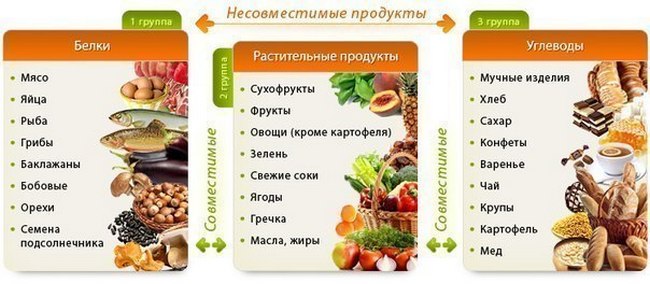
And yet, when compiling your diet, you must take into account the individual characteristics of the body, because the question of taste preferences is purely intimate and personal. Do not impose your opinion on any person if he is comfortable eating in a certain way. And turning to a specialist nutritionist for advice, you will receive a well-composed, full-fledged menu that suits you.
Separate nutrition, like a pyramid-based system, refers to the "omnivorous" form of nutrition. The main idea of \u200b\u200bseparate nutrition is not to eat at the same time incompatible friend with other products.
In this article we will consider the basic principles of separate nutrition, the pros and cons of separate nutrition and the use of the separate nutrition system for weight loss.
I have compiled a convenient list of food compatibility for separate meals: product categories are arranged in an order that complies with the principles of separate meals.
SEPARATE FOOD
The principles of separate nutrition.
All components of food products are conventionally divided into 3 main groups - proteins, fats and carbohydrates. Fats are compatible with almost all types of products. And proteins and carbohydrates do not combine with each other, since protein requires an acidic environment for digestion, and alkaline for carbohydrates.
Different products require different conditions for assimilation, and it takes them to digest different time. For example, fruits are digested in 30 minutes, and meat passes through the digestive tract for several hours. If incompatible products enter the stomach together, the longest digestion process starts. As a result, poorly digested foods do not leave the gastrointestinal tract for a long time, causing putrefactive processes, poisoning the body, settling on the intestinal walls in the form of toxins and contributing to obesity.
In addition, nutrients from incompatible products are poorly absorbed. Minerals and vitamins are also not fully absorbed.
The matter is complicated by the fact that proteins, fats and carbohydrates are present together in almost all foods, albeit in different proportions. Thus, it is impossible to completely separate proteins, fats and carbohydrates. In addition, proteins, fats and carbohydrates vary in composition.
Therefore, in separate meals, the products are not divided into 3 categories, but into 18 (see).
The principles of separate power are simple:
- Eat only compatible foods in one meal.
- Observe a break between meals (2 hours). In addition to fruits, after which you can eat other products in 15-20 minutes.
A break is needed so that the food is completely digested and removed from the body before a new serving arrives. In addition, a two-hour break gives rest to the digestive system.
Compatibility of products with separate nutrition.
There are different options for the separation of products for compatibility with separate nutrition. We will take the most complete list - 18 product categories:
Products belonging to the same category are combined with each other and can be consumed in one meal. Compatibility of products from different categories is indicated below (c). Accordingly, products from compatible categories can be consumed in one meal, but incompatible products cannot.
The list of product compatibility for the separate power supply system indicates for each product category:
- Which products are compatible with which (a combination of such products in one meal is possible and desirable).
- Which products are compatible with the average (a combination of such products is acceptable, but not desirable).
- Not mentioned product categories should not be used together with products of this category - they are not compatible.
Distributed compatibility tables for separate meals, in which all categories are mixed together. Looking at such tables, it is difficult to grasp the logic that underlies the compatibility of products. I tried to place the categories of products in the order that allows us to understand the separate food system and remember which products are compatible and which are not.
Separate Food Compatibility List:
1. Meat (red meat, poultry) and fish.
2 eggs .
Medium Compatibility:
3. Butter, cream.
Good compatibility:
Medium Compatibility:
4. Sour cream.
Good compatibility:
Medium Compatibility:
5. Milk.
Medium Compatibility:
6. Sour-milk products, cottage cheese.
Good compatibility:
Medium Compatibility:
7. Cheese, feta cheese.
Good compatibility:
Medium Compatibility:
8. Sugar, confectionery, jams, syrups.
In accordance with the principles of separate nutrition, confectionery mixes well with green vegetables, because they help to neutralize the harmful effects of these products. But who wants to bite a piece of cake with salad and parsley? therefore, it can be said that confectionery, jams and syrups are not combined with anything.
9. Vegetable oil.
Unrefined oil used in raw form, preferably cold pressed.
Good compatibility:
Medium Compatibility:
Vegetable fats - a product necessary for health, which must be included in your menu. As you can see, vegetable oil goes well with many products. It is important to use it in combination with vegetables, since it is necessary for the absorption of many fat-soluble vitamins.
10. Legumes.
Peas, lentils, beans, soy, chickpeas.
Good compatibility:
Medium Compatibility:
11. Cereals, cereals and potatoes - starchy foods.
Bread, pasta, buckwheat, millet, rice and other cereals, potatoes.
Good compatibility:
Medium Compatibility:
12. Starchy vegetables and roots.
Pumpkin, zucchini, squash, cauliflower, carrots, horseradish, beets, parsley root, celery root.
Good compatibility:
Medium Compatibility:
13. Green vegetables, non-starchy vegetables, greens.
Eggplant, cucumbers, white cabbage, bell pepper, onions (green and onions), garlic, lettuce, parsley, dill, beets, celery and other edible herbs).
It also includes radishes, radishes, turnips and rutabaga, although they are somewhere between starchy and non-starchy vegetables.
Good compatibility:
Non-starchy vegetables and greens go well with virtually all foods except milk.
14. Tomatoes, sour fruits and berries.
All citrus fruits (oranges, tangerines, lemons, grapefruits). Pineapples, pomegranates, cranberries and all sour-tasting fruits and berries (apples, pears, peaches, apricots, plums, grapes).
Good compatibility:
Medium Compatibility:
15. Semisweet fruits and berries.
Raspberries, blueberries, strawberries, cherries, cherries, apples, pears, peaches, apricots, plums, grapes.
Good compatibility:
Medium Compatibility:
16. Sweet fruits and dried fruits.
- The principles of separate nutrition do not stipulate which foods should be included in the daily menu in order to provide the body with all the necessary nutrients. To prevent a shortage of any substances (proteins, fats, carbohydrates, vitamins and minerals), you should maximize your diet. When compiling the menu, you can use the food pyramid.
- The main claim for separate nutrition is that separate nutrition "wean" the body to digest incompatible products. As a result, if in the future a person eats incompatible foods, then upset stomach will work. If for you the impossibility to try all the dishes on the festive table is the same as disability, then separate meals are not for you.
- Often, when switching to separate nutrition, a person feels constant hunger. Many believe that it should be so. I have reason to believe that this is not true. Separate nutrition alone should not cause any discomfort. A constant feeling of hunger can occur if you dramatically change your diet. Separate nutrition does not require such a change. In order to avoid constant hunger when switching to separate nutrition, you need to divide the usual dishes into their constituent parts and make a new menu from them, in accordance with the principles of separate nutrition (combining compatible products). Thus, the daily diet will remain the same - as you know, the amount does not change from a change in the places of the terms. Then, when the body adapts to separate nutrition, it will be possible to gradually change the diet. With such a gradual transition to separate nutrition, you are not threatened by constant hunger or lack of substances necessary for health.
- Some say that on separate meals it is impossible to get pleasure from eating. Here, of course, everything is individual. If this is your problem, then I would advise you to simply allow yourself to sometimes eat something “wrong” (not corresponding to the principles of separate nutrition) if you really want to eat just that. And do not torment yourself with any remorse! Over time, the desire to eat something “wrong” will appear less and less until it disappears altogether (it doesn’t matter when this happens - in a few weeks or a few months).
- Separate nutrition complicates life somewhat. Especially when you have to eat out. Often you have to choose between convenience and health. You won’t do anything about it.
Separate nutrition for weight loss.
Usually excess weight is a consequence of problems such as:
- constipation, digestive disorders, severe slagging of the body,
- metabolic disorders (protein, fat and carbohydrate metabolism),
- overeating.
Separate nutrition eliminates most of these problems. Thus, separate nutrition eliminates the causes of excess fat accumulation. Often, switching to separate nutrition is enough to start the process of losing weight.
I would not recommend treating a separate diet as a diet and drastically reducing the calorie content of your daily diet. There are several reasons for this:
- Firstly, this may not be required. Separate nutrition and so starts the process of natural weight loss.
- Secondly, a low-calorie diet is effective for a short time. At the same time, the diet provokes weight gain at its end.
- A low-calorie diet is always accompanied by loss of muscle mass, which is then replaced by adipose tissue.
Separate nutrition does not help to avoid the majority of the negative effects of the diet. The only thing that separate nutrition can help is that digestion with separate nutrition will be more effective, which will help to avoid a significant shortage of any nutrients, which is a common problem in any low-calorie diet.
Instead of limiting the amount of food, you can speed up weight loss by other methods.
Weight loss on a separate diet will contribute to:
- Body cleansing. The best effect will be given by cleansing the body in full. But even just bowel cleansing (especially with hydrocolonotherapy aerobic and anaerobic loads,
- or engage in problem areas by performing exercises for individual muscle groups.
The most persistent effect gives a gradual, natural weight loss. Separate nutrition is suitable for such weight loss as well as possible. Remember that a constant feeling of hunger is not at all mandatory when losing weight. On the contrary, if you experience discomfort after switching to separate meals, then you should review your menu. Be sure to get all the necessary nutrients in sufficient quantities. The food pyramid will help you with this. Perhaps you should make meals more frequent - this will help satisfy all the needs of the body. More frequent meals (fractional meals) go well with separate food and also contribute to weight loss.
It is important to know which foods can be consumed together, in what sequence, and which ones to eat separately.
If quickly digested food is consumed after food in need of lengthy processing, then the last portion of food is not removed in a timely manner due to the fact that the exit from the stomach is blocked by food requiring prolonged digestion.
After eating, astringent foods, such as quince or foods that aid in decomposing foods, should not be consumed. If you eat garlic after cabbage, then the cabbage will not be digested, but will rot. An apple eaten on an empty stomach leaves the stomach for 15-20 minutes, and oranges are even faster. If the fruits are eaten for dessert after a hearty dinner, then they remain in the stomach along with the long-digested food and after 20 minutes they begin to ferment.
Each type of food requires a specific enzyme composition. This means that for digesting a particular food, a special composition of gastric juice is necessary. And other conditions for the digestion of a particular product differ from each other - for the digestion of proteins an acidic environment is necessary, while starchy food is broken down in an alkaline environment, and acidity will only inhibit the activity of the necessary enzyme. Therefore, it is better not to eat protein and starchy foods together.
Carbohydrates are better not to eat with acidic foodsfor example, vinegar, lemon or ketchup. If you drink bread with tomato juice, then the activity of the amylase in the saliva, the enzyme responsible for the breakdown of starchy foods, is suppressed.
There is also a phase of intestinal digestion, when, under the influence of the juice of the pancreas, the food slurry that leaves the stomach breaks down. But a complete breakdown of the food slurry in the small intestine is possible only if the food in the stomach is fully processed.
For instance, porridge on the water it breaks down quickly under the influence of a not very strong gastric juice and quickly leaves the stomach. If you eat porridge together with meat, the stomach cannot develop gastric juice of the composition that is necessary for both foods. Therefore, such food remains in the stomach for too long and leaves the stomach incompletely split. Of course, pancreatic juice will bring the digestion of this food to the end, but it will require additional load on the liver, pancreas and small intestine. And the eater himself will feel the "stone in the stomach."
It is also essential that beneficial microorganisms predominantly feed on plant fiber, and meat contributes to the multiplication of microflora, which determines the decomposition of food.
The human digestive tract is intended for plant foods: fruits, cereals, vegetables and herbs. The bacteria in the gut are important. The conversion of fiber into either nutrients or toxins depends on them. The quality processing of the remaining nutrients also depends on microorganisms. If a person eats correctly, then the result is on the face: the feces have practically no smell, no gases are formed.
BASIC FOOD RULES
1. foods containing starch, sugar, not eaten with proteins and acid fruits
2. the interval between meals at least 4 hours
3. Do not eat refined foods (flour, sugar, margarine)
GROUPS OF PRODUCTS AND THEIR COMBINATIONS
Sweet Fruits:
Bananas, dates, persimmons, figs, all dried fruits. Fruits break down quickly, sweet fruits linger in the stomach a little longer than sour fruits. Fruits must be taken separately, for example, for an afternoon snack or before the meal. It is very unfavorable to eat fruit after eating, because then fermentation begins in the stomach. Apart from eating other foods, you must drink fruit juices, because they are concentrated food. Sweet fruits combine well with each other, as well as with semi-sour fruits, such as persimmons and apples. Bananas are worse combined with other fruits. Sfdkie fruits can be combined with cream, sour cream, herbs and dairy products.
Half-sour fruit:
Mango, blueberries, blueberries, strawberries, raspberries, apples, pears, plums, grapes, apricot, peach, watermelon. These fruits can be combined with sweet fruits, sour fruits, dairy products, cream, herbs, as well as protein foods containing lots of fats, such as cheese, nuts, fatty cottage cheese. These fruits cannot be combined with eggs, fish, mushrooms, peas and legumes. It is not advisable to consume these fruits with starchy foods. In a separate meal, eat peaches, blueberries, blueberries, grapes, melon and watermelon, because these fruits are processed very quickly in the stomach and do not combine well with other foods.
Sour fruits:
Oranges, tangerines, grapefruits, pineapples, pomegranates, lemons, gooseberries, cranberries, sour apples, pears, plums, apricots, grapes.
These fruits are well compatible both among themselves and with fermented milk products, cream, sour cream and fatty cottage cheese.
They can be combined with nuts, cheeses and herbs.
Sour fruits are not compatible with animal proteins, legumes, peas, starchy foods and vegetables.
Well-combined vegetables:
Cucumbers, fresh cabbage (except cauliflower), radish, bell peppers, beans, turnips, onions, garlic, beets, rutabaga, carrots, early zucchini, early pumpkin, salad.
These vegetables are well combined with any food, contributing to its digestibility, for example, with proteins (meat with cucumbers, carrots with cottage cheese), with fats (cabbage and butter), with other vegetables, with products containing starch (bread with beets, with greens .
You can not combine vegetables with milk!
It is undesirable to eat vegetables and fruits at the same time.
Badly combined vegetables:
Cauliflower, green peas, late zucchini, late pumpkin, eggplant, squash.
These vegetables are perfectly combined with products containing starch, for example, bread, with all vegetables, fats, for example, sour cream and herbs.
It is permissible to use with cheeses.
A combination of these vegetables with animal proteins, such as eggs and meat, is less desirable.
Absolutely incompatible with milk and fruit.
Products containing starch:
Wheat, rye, oats and products from these cereals, such as pasta and bread, as well as buckwheat, rice, potatoes, edible chestnut and corn.
Perfectly combined with greens, fats and all vegetables.
A combination of these products among themselves is also acceptable. This should be avoided by people with a tendency to be overweight. In addition, different cereals differ among themselves in the amount of protein, so it is better not to combine cereals with each other.
When combining starch-containing foods with fats, you must add greens or vegetables at the same time.
A very unfavorable combination of carbohydrates and proteins. It is especially important not to combine carbohydrates with meat, milk and fermented milk products, for example, porridge with milk, bread with kefir. It is undesirable to combine starchy foods with sugars, for example, bread with jam, porridge with sugar, as well as with any fruit or fruit juices.
Protein products:
Meat, fish, eggs, cottage cheese, cheeses, feta cheese, milk, buttermilk, kefir, legumes, lentils, peas, nuts, seeds, mushrooms.
Ideal with seeds and well-matched vegetables. Contribute to the processing of proteins and the elimination of various toxins.
Exceptions include milk - it must be eaten separately. It is better to give preference to warm, unboiled, unpasteurized milk. Pasteurized milk is very heavy in quality. In some cases, milk can be combined with sweet fruits, such as bananas, but each person has their own individual tolerance to the products.
A combination of proteins with fats is acceptableMoreover, animal fats are better combined with animal proteins, and vegetable proteins - with vegetable fats. It must be borne in mind that fats slow down the digestion process. To improve digestion, it is necessary to combine with fresh vegetables and herbs.
Proteins cannot be combined with starch products, fruits and sugars.
Exceptions include cottage cheese, cheeses, dairy products, nuts and seeds - they can be combined with fruits.
Greens:
Salad, dandelions, nettle, plantain, chives, sorrel, coriander, parsley, acacia, rose petals, dill, etc. Greens are compatible with all products except milk.
Fats:
Butter and ghee, sour cream, cream, vegetable oils, lard and other animal fats. Sometimes fatty meat, fatty fish and nuts are included here.
Fats slow down the secretion of gastric juice, especially if consumed at the beginning of a meal. But sometimes, fat intake destroys congestion in the stomach caused by an unsuccessful combination of foods
Fats go well with herbs, vegetables, and starchy foods, such as porridge with butter. In some cases, a combination of fats and fruits is permissible, especially for berries, for example, strawberries with cream.
You can not combine fats with sugars, for example, cream with sugar. Ghee is compatible with almost all products. Vegetable oils are best consumed with fish that contain a lot of unsaturated fatty acids. It is better not to combine fats with meat.
Sahara:
Fructose, jam, honey, molasses, brown sugar, syrups.
Together with proteins and starchy foods cause fermentation, contributes to the decomposition of other products.
Sweets are best consumed separately, but you can not do this at the end of the meal. Ideally, it is better to give up sweets or eat them as a separate meal.
The exception is honey. In a small amount, honey is recommended to be taken together with other food products, since honey promotes the absorption of biologically active substances and delays food rotting processes. Honey can not be combined only with animal products. Honey cannot be heated because it becomes toxic.
Meat, fish, cottage cheese and cheese is a very concentrated protein food. Without them, it is possible to live, if possible, you should not eat these foods daily.
After eating, it is advisable to sit at the table for at least 5 minutes, and then slowly walk for 20 minutes.
- NEVER EAT CARBOHYDRATE AND ACID FOOD IN ONE FOOD RECEPTION
Bread, potatoes, peas, beans, beans, bananas, dates and other carbohydrate foods should not be eaten with lemon, orange, grapefruit, pineapple, cranberries, tomatoes and other sour fruits.
- NEVER EAT CONCENTRATED PROTEIN AND CONCENTRATED CARBOHYDRATE IN ONE FOOD RECEPTION
This means: do not eat nuts, meat, eggs, cheese and other protein foods along with bread, cereals, pastries, sweet fruits. At one time you need to eat eggs, fish, milk, cheese, in the other - bread, cereals, noodles (if there is no way to refuse them).
- NEVER EAT TWO CONCENTRATED PROTEINS IN ONE FOOD RECEPTION
Two proteins of different types and different compositions require different digestive juices and their different concentrations. These juices are not secreted into the stomach at the same time. Therefore, you should always follow the rule: ONE PROTEIN IN ONE FOOD RECEPTION.
- DO NOT EAT FAT WITH PROTEINS
Cream, butter, sour cream, vegetable oil should not be eaten with meat, eggs, cheese, nuts and other proteins. Fat inhibits the action of the gastric glands and inhibits the secretion of gastric juices when eating meat, eggs, nuts.
- DO NOT EAT ACID FRUITS WITH PROTEINS
Oranges, lemons, tomatoes, pineapples, cherries, sour plums, sour apples, can not be eaten with meat, nuts, eggs. The less complex the food mixtures, the simpler our dishes, the more efficient our digestion.
- DO NOT EAT STARCH AND SUGAR IN ONE FOOD RECEPTION
Jelly, jams, fruit butter, molasses sugar, syrups on bread or in one go with cereals, potatoes, sugar with cereals - all this causes fermentation.
- EAT ONLY ONE CONCENTRATED STARCH IN ONE FOOD RECEPTION
If two types of starch (potatoes or porridge with bread) are used in one step, then one of them goes to assimilation, and the other remains intact in the stomach, like a load, the intestines do not pass, delays the absorption of other foods, causes its fermentation, increases gastric acidity juice, burping, etc.
- DO NOT EAT MELON WITH ANY OTHER FOOD
Watermelon, honey, musky and other types of melons should always be eaten separately.
- MILK IS BETTER TO TAKE SEPARATELY OR DO NOT TAKE AT ALL
Fat milk for some time prevents the secretion of gastric juice. Milk is not absorbed in the stomach, but in the duodenum, therefore, the stomach does not respond to the presence of milk by secretion, which interferes with the absorption of other foods.
ON A NOTE:
Experts have found that there are a lot of products that are better not to use together. Often, seizing one product with another, we not only simply lose money, but also cause serious harm to your health.
Let's look at specific examples of what and in what combination to use together is not worth it:
Green tea with milk
Green tea is an excellent antioxidant. Diluting it with milk or cream, we neutralize this property of it, nullifying all the beneficial properties that it contains.
Kiwi and yogurt (kefir)
Kiwi is often one of the components of various milkshakes. Using them, according to experts, we kill the nutritional value of this fruit. The enzyme contained in kiwi, when added to dairy products, contributes to the decomposition of milk protein, giving the drink a bitter taste.
Rye bread and coffee
A sandwich with rye bread and strong aromatic coffee is one of the most common breakfast options. But since coffee is a well-known antioxidant, it interferes with the absorption of vitamins and minerals, which are abundant in the composition rye bread. Experts recommend using these products independently of each other.
Spinach, green salad and ... salt
As it turned out, salt is able to draw out all the beneficial substances that make up green lettuce and spinach, making their use completely useless.
Tomatoes and starch products
Tomatoes are a frequent guest on our table. However, nutritionists caution us against using them with any food that contains starch. The fact is that the acids that are part of tomatoes are contraindicated in the absorption of starch by the body. Most polysaccharides are found in potatoes and various cereals.
Olive oil at any heat
It turned out that frying products in olive oil, as well as, in principle, any of its heating leads to an irretrievable loss of all its important nutritional properties. Specialists recommend using olive oil exclusively in cold form. For example, as salad dressings.
Melon with milk
This combination can only lead to frustration. gastrointestinal tract. It is not recommended to eat melon with any sour-milk products.
Jam and protein foods
Any sweets, whether jam, confiture or syrup, when combined with protein foods, cause strong fermentation, contributing to the decomposition of other products. Nutritionists recommend refraining from eating any sweet desserts with bread (with the exception of honey).
Salted foods with watermelon
Eating too much salty foods can cause severe swelling. And when combining pickles with watermelon, which is 80% water, an unnecessary effect is formed in the form of a swollen face and legs.
Sparkling water with milk
Using these products together, you cause serious trouble to your stomach, which will respond to such a combination with belching, heaviness and abdominal pain.
Herring with milk
- A classic example of product incompatibility. Herring with milk, once in the stomach, causes oxidation, leading to coagulation dairy product. The body's reaction to these products is always individual - from indigestion to poisoning.
Fruits as a third dish
Eating “on the third” fruit, we inflict irreparable harm on our stomach. After all, eating a fruit dessert after hot dishes, which, as a rule, are digested for at least half an hour, we force the fruit to rot in the stomach.
Beer and Peanuts
It's no secret that the combination of these products is one of the most popular at any party. Peanuts, belonging to the legume family, in combination with beer lose all their useful propertiesturning into a product that creates the effect of extraordinary heaviness in the stomach.
Coca-Cola and alcohol
Coca-Cola decided to drink alcoholic beverages. It is part of a number of alcoholic cocktails. However, as it turned out, cola with alcohol forms a reactive combination capable of large quantities bring serious harm to human health.
And:
- never eat concentrated protein and concentrated carbohydrate at one meal (fish, meat, eggs can not be eaten along with bread, potatoes, sweet fruits);
- never eat two concentrated proteins at one meal (you can not eat meat and fish, or eggs and meat, or cheese and eggs, etc., at one meal);
- Do not eat fats with proteins (i.e. cream, butter and vegetable oil with meat, eggs, cheese, nuts);
- Do not eat sour fruits with proteins (i.e., oranges, lemons, pineapples, tomatoes and other acids should not be eaten with meat, eggs, cheese, nuts).
do not eat starches and sugar in one meal (jelly, jams, sugar, honey can not be consumed with cereals, potatoes, etc.);
- eat only one concentrated starch in one meal, as overeating starch leads to fermentation.
Good nutrition and nutritional myths
Internet conference about nutrition. Nutrition systems, nutritional myths, true nutritional laws, and science-based fallacies.
author - Mikhail Yatsyk
How to eat right, where to start
Official blog of the author http://blog.yatsyk.ru/
source http://clubs.ya.ru/4611686018427470127






